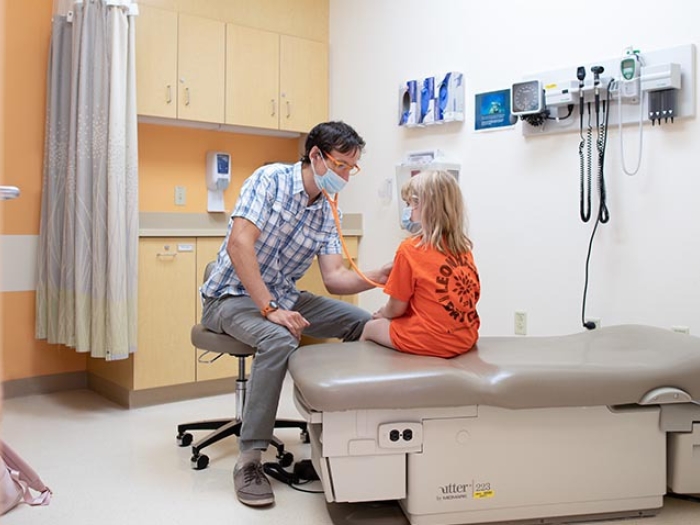Tests that provide molecular details on a specific tumor aren’t routinely done for pediatric brain tumors, but research suggests the extra step could change a child’s therapy.
8:14 AM
Author |

They're among the most ruthless opponents for pediatric oncologists: brain tumors that can't be surgically removed or that resist standard therapies.
Doctors have limited weapons to fight them, contributing to why brain cancer is still the leading cause of cancer-related death in children.
But some institutions are re-thinking their approach.
DNA and RNA sequencing, which provide detailed molecular profiles for tumors, already play a role in personalizing therapy for patients with certain types of cancer. But the tests, which uncover a tumor's unique combination of genetic mutations, aren't a routine part of care and not always covered by insurance companies that don't perceive them as critical.
But leaders in the field want to see that change.
A collaboration among several institutions, spearheaded by University of Michigan's C.S. Mott Children's Hospital, led to a review of four separate major studies finding evidence that molecular profiling and targeting of pediatric brain tumors could alter a child's treatment.
Authors concluded that when it comes to children with high risk brain tumors, comprehensive sequencing should be the standard of care – everywhere. The call to action on pediatric cancer treatment was published in high profile journal Neuro-Oncology.
"It's devastating to have to tell a family we have run out of available options for treating their child's brain tumor," says senior author Carl Koschmann, M.D., Mott pediatric oncologist and researcher with the Chad Carr Pediatric Brain Tumor Center at Michigan Medicine.
"Brain cancer is the leading cause of cancer death among children. We have to shift the paradigm in how we manage these cases. Younger patients with high risk or relapsed brain cancer urgently need novel effective therapies based on the unique biology of each child's specific tumor."
A strong foundation for sequencing
The U-M Rogel Cancer Center launched an ambitious cancer sequencing program in 2011 with a focus on adult patients whose cancer hadn't responded to standard treatment. It was extended to pediatric patients, making Mott among the first in the country to use real-time sequencing in the care of high-risk pediatric tumors.
Genomic testing is a significant undertaking, involving taking samples of a patient's tumor and healthy tissue and sequencing the DNA and RNA of both to compare them. This helps isolate the genetic mutations associated with the disease to help determine which mutations are driving the cancer and to match patients with treatment options that target those mutations.
At Mott, all high risk pediatric brain tumors are now routinely sequenced through the Mi-ONCOSEQ program, led by Rajen Mody, MBBS, director of pediatric oncology at Mott and Arul Chinnaiyan, M.D., Ph.D., director of the Michigan Center for Translational Pathology. Because Mi-ONCOSEQ is run as a research protocol, there's no fee to patients.
The team has sequenced over 500 pediatric tumors since 2011 using a combination of DNA and RNA sequencing.
"Our sequencing experience suggests that glial brain tumors, along with soft tissue sarcoma and lymphoid leukemia, have the highest rate of actionable genomic alterations," Mody says. "Hopefully these findings will lead to the development of novel, more effective therapies, including targeted biological agents and immunotherapy against high-grade pediatric brain tumors."
A recent Mott study found that sequencing revealed a potentially actionable tumor alteration in 25 out of 40 children (63%) treated for brain cancer. Among those, 53%, or 21, resulted in an impact on treatment or change in diagnosis.
Two-thirds of patients with glial tumors (17 of 20) were also found to have a potentially actionable result, which resulted in change of therapy in 14 patients (70%).
"We have seen cases where sequencing dramatically changed our idea of what kind of tumor we thought we were looking at," Koschmann says. "When we didn't have a good drug or therapy for that tumor, we could get the patient into a clinical trial based on the new information we found."
Finding answers through collaboration
Other institutions are experiencing similar results, reporting that sequencing triggers a change in therapy in the majority of pediatric patients with glial tumors. This included separate research at Michigan, Boston Children's Hospital at Harvard, Seattle Children's and University of California, San Francisco Benioff Children's Hospital.
"We collaborated with peers and shared our data, concluding that sequencing high risk pediatric brain tumors is feasible and has potential to change therapy," Koschmann says. "We now have enough evidence to support sequencing being incorporated into clinical care for most or all glioma patients."
Koschmann says authors at the peer institutions put together "a much-needed consensus statement" for recommendations on when to pursue tumor DNA sequencing. The group also outlines when to pursue additional molecular tests, such as germline sequencing, RNA-sequencing or methylation sequencing.
Brain cancer is the leading cause of cancer death among children. We have to shift the paradigm in how we manage these cases.Carl Koschmann, M.D.
One caveat: this form of precision medicine doesn't guarantee improving a child's long term outcome. Scientists can't always identify which mutation is driving the cancer. When they can, there isn't always a drug available to treat it, or the drug might not work.
But Koschmann says that as sequencing is used for more high risk brain tumors in kids, researchers will have a more accurate way to track how resulting changes in treatment benefit children.
"We see this as a roadmap for managing the hardest-to-treat brain tumors and to move the field forward," he says.
Barriers in routine sequencing
Mott is among less than a dozen pediatric centers in the country that offer high quality in-house sequencing for high risk brain tumors, Koschmann says.
Among barriers to making the practice widespread and routine are resources, expertise and insurance coverage.
But as an increasing number of leaders report promising experiences with sequencing, the hope is that more centers gain this capability themselves or establish a referral process to send patients to an experienced site, Koschmann says.
"Incorporating sequencing into the care of children with brain tumors has moved from what may have been considered experimental and fringe to more mainstream and regularly practiced," Koschmann says. "We need to solidify this concept to help bring insurance companies on board and encourage other centers to make this available to their patients.
"Our goal is to see sequencing become a built-in part of care. We should always seek a deeper molecular understanding of each individual tumor to guide therapeutic decisions."
Michigan Medicine's pediatric brain tumor research has gained momentum in recent years, accelerated by the creation of the Chad Carr Pediatric Brain Tumor Center in 2017. Families of children with high risk brain tumors have travelled from across the country to Mott for care.
On the clinical side, Koschmann works with a team that includes Mott neuro-oncologist Patricia Robertson, M.D. and Marcia Leonard, NP. Neuro-oncologist Andrea Franson, M.D. also recently joined the group to focus on further building the clinical trial infrastructure.
The center's opportunities for research were buoyed in September when Michigan Medicine was added to the exclusive Pacific Pediatric Neuro-Oncology Consortium. Being part of the consortium gives Mott patients more access to promising clinical trials.
The consortium, which includes 18 of the nation's top childhood cancer centers, allows researchers from around the world to share data in real time and conduct more clinical trials at a faster pace.
Michigan Medicine was selected largely because of the transformative work being done at the center, says Koschmann, who now serves as the consortium's clinical trial co-lead.
"It's an exciting time to be part of this movement, Koschmann says. "We hope that in the next 5-10 years, new studies will help us improve diagnosis and treatment for children with high risk brain tumors."
"But it's a rapidly evolving field, and we have a long way to go."

Explore a variety of health care news & stories by visiting the Health Lab home page for more articles.

Department of Communication at Michigan Medicine
Want top health & research news weekly? Sign up for Health Lab’s newsletters today!





